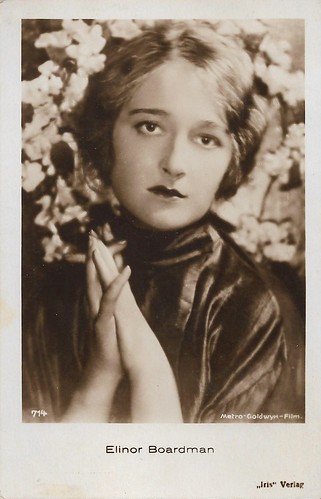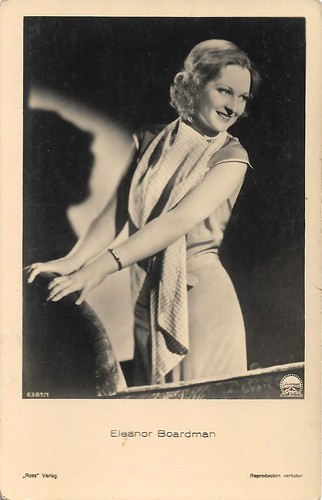
French postcard by A.N., Paris, no. 507. Photo: Metro-Goldwyn-Film.

Austrian postcard by Iris Verlag, Wien, no. 426. Photo: Metro-Goldwyn-Film.

Austrian postcard by Iris Verlag, Wien, no. 714. Photo: Metro-Goldwyn-Film. The first name of Boardman is misspelt.

Austrian postcard by Iris Verlag, no. 6115. Photo: Metro-Goldwyn-Mayer.

Italian postcard by Cinema-Illustrazione, Milano, series 1, no. 15. Photo: Metro-Goldwyn-Mayer.
The new face of 1922
Eleanor Boardman was born in Philadelphia, Illinois, in 1898. She always wanted to be an actress, and as soon as she graduated from Philadelphia's Academy of Fine Arts, she headed for New York to conquer Broadway. An attempt to become a stage actress came to nought when Eleanor came down with laryngitis.
When Broadway proved not quite ready to be conquered yet, she took whatever jobs she could find. She became a photographer's model. Her best work was as 'The Eastman Kodak Girl' for the Eastman company in the late 1910s. In that capacity, she heard that the Selwyn Organisation, a major producer of Broadway plays, was looking for girls with no stage experience. Since she was more than qualified in that respect, she tried out for the job and before she knew it she was in the chorus line of 'Rock-a-Bye-Baby' until the show closed three months later.
She then got a job in another Selwyn production, 'A Very Good Young Man', but that show closed not long after opening. It was at this time that a casting director for Goldwyn Pictures hit the Broadway scene looking for new faces. She tested for him and impressed him enough that he finally picked her out of a pool of more than 1000 young girls who tested for the opportunity to go to Hollywood. She was chosen by Goldwyn Pictures as their 'New Face of 1922', through which she signed a contract with the company.
After several successful supporting roles, she played the lead in Rupert Hughes' Souls for Sale (1923), also with Frank Mayo, Richard Dix, and Lew Cody. Boardman plays a runaway wife who ends up in Hollywood and from an extra becomes a star. Her husband (Cody), apparently a dangerous robber and killer of wives, pursues her. The film gives an insight view of Hollywood and many silent stars had cameos in the film.
That same year, Boardman's growing popularity was reflected by her inclusion on the list of WAMPAS Baby Stars. When Goldwyn was absorbed into MGM, Boardman became one of that studio's earliest, busiest and most popular leading ladies.

French postcard by A.N., Paris, no. 322. Photo: Metro-Goldwyn-Production. John Gilbert and Eleanor Boardman in Bardelys the Magnificent (King Vidor, 1926).

French postcard by Europe, no. 800. Photo: Metro-Goldwyn-Mayer. John Gilbert and Eleanor Boardman in Redemption (Fred Niblo, 1930).

French postcard by Europe, no. 864. Photo: Metro-Goldwyn-Mayer. John Gilbert and Eleanor Boardman in Redemption (Fred Niblo, 1930).

German postcard by Ross Verlag, Berlin, no. 5090/2. Photo: Metro-Goldwyn-Mayer. Eleanor Boardman and John Gilbert in the early sound film Redemption (Fred Niblo, 1930).

German postcard by Ross Verlag, Berlin, no. 5343/1, 1930-1931. Photo: MGM. Eleanor Boardman and Conrad Nagel in The Only Thing (1925).
King Vidor
Eleanor Boardman appeared in more than 30 films during her career, achieving her greatest success in director King Vidor's The Crowd (1928). Hal Erickson at AllMovie: "Customed to glamourous, sophisticated roles, Eleanor balked when she was asked in 1928 by then-husband King Vidor to appear as the plain, tenement dwelling housewife in Vidor's The Crowd. She acceded to his wishes, and the result was one of the actress' finest performances (and certainly her most memorable)." Other memorable titles were e.g. The Circle (Frank Borzage, 1925), Bardelys the Magnificent (King Vidor, 1926) with John Gilbert, and Tell It to the Marines (George W. Hill, 1926) with William Haines and Lon Chaney.
She managed to survive the switchover to sound films with good roles in such films as The Great Meadow (Charles Brabin, 1931) and The Squaw Man (Cecil B. DeMille, 1931) featuring Warner Baxter, but her MGM contract was terminated as a result of an economy drive. Boardman retired from acting in 1935 and retreated from Hollywood. Her only subsequent appearance was in an interview filmed for Kevin Brownlow and David Gill's British documentary series Hollywood (1980). From 1926 to 1931, Eleanor Boardman was married to King Vidor and she had two daughters, Antonia (1927-2012) and Belinda (1930), with him. According to Boardman, she and Vidor were scheduled to be married in 1927 at a double ceremony with John Gilbert and Greta Garbo. Garbo got cold feet and did not show up. Boardman and Vidor did get married at the home of Marion Davies, who gave the bride away.
Marlene Pilaete comments: "Several years ago, I made a research on the double marriage 'Boardman-Vidor' and 'Garbo-Gilbert' and I’ve found out that this info was highly questionable. It seems that Eleanor Boardman was the only person present at the wedding to tell this story. No one else ever mentioned it. It’s interesting to note that King Vidor doesn’t mention this incident in his autobiography 'A Tree Is a Tree'. A biographer even went so far as trying to find a marriage license. She found the application for a marriage license regarding Bordman and Vidor but there was no trace of a Garbo-Gilbert license in the archives of Los Angeles, Orange and Riverside counties. All this casts strong doubts on Eleanor Boardman’s allegations."
After her retirement, Boardman moved to Europe, where she married director Harry d'Abbadie d'Arrast in 1940. He had directed her final film, the multinational (and multilingual) d'Arrast project The Three-Cornered Hat (Harry d'Abbadie d'Arrast, 1935) with Victor Varconi. After the war, she divided her time between the United States and their chateau in the Pyrenees Mountains. After her husband's death in 1968, she permanently relocated back to the United States, where she settled into Montecito, an upper-class suburb of San Bernardino, California, living in a house she designed.
Eleanor Boardman died in her sleep at her home in 1991, at the age of 93. Her ashes were scattered in Santa Barbara near her home. After her death, she was profiled in 'Speaking of Silents: First Ladies of the Screen' by William Drew in 1997. For her contributions to the film industry, Boardman has a motion picture star on the Hollywood Walk of Fame. Her star is located at 6928 Hollywood Boulevard.

French postcard by Editions Cinémagazine, no. 255.

French postcard in the Les vedettes de cinéma series by A.N., Paris, no. 210. Photo: Metro Goldwyn Production.

German postcard by Ross Verlag, Berlin, no. 1309/1, 1927-1928. Photo: Loew-Metro-Goldwyn. It was in 1924 that Marcus Loew who already owed Metro Pictures bought the company Goldwyn Pictures. In 1925 the company would be named Metro-Goldwyn-Mayer. So this photo may date from 1924.

German postcard by Ross Verlag, Berlin, no. 6387/1, 1931-1932. Photo: Paramount. The only early 1930s Paramount film in which Eleanor Boardman acted was Women Love Once (Edward Goodman, 1931) with Paul Lukas and herself in the leads.

British postcard in the Film Partners Series, no. PC6, London. Photo: Columbia. Monte Blue and Eleanor Boardman in The Flood (James Tinling, 1931).
Three Reasons: The Crowd. Source: Robert Nishimura (YouTube).
Source: Marlene Pilaete in a mail to EFSP, Hal Erickson (AllMovie), Wikipedia and IMDb.
This post was last updated on 11 June 2023.
No comments:
Post a Comment